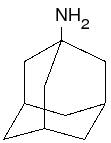Adults over age 65 are at higher risk of severe illness and death from influenza A virus, compared with the general population. Rates of the incidence of influenza are reported to be as high as 60 percent in residents of nursing homes and retirement homes. During these epidemics, mortality rates can approach 30 percent. As a result, the Immunization Practices Advisory Committee of the Centers for Disease Control recommends influenza vaccination or prophylactic treatment with amantadine, or both, in persons at high risk of infection during an influenza outbreak. However, both of these strategies have their limitations.
The efficacy of influenza vaccine in nursing home residents is estimated to be less than 30 percent. Amantadine, taken daily before and during exposure to the influenza A virus, has been shown to be 35 to 91 percent effective in preventing clinical disease. Amantadine is not effective against influenza B infections. Previous studies suggest that 20 to 33 percent of persons taking amantadine report side effects. However, most of these results are from studies in healthy young volunteers. Stange and colleagues conducted a retrospective cohort study to determine the incidence of adverse reactions to amantadine in the elderly and to identify risk factors for side effects.
The study included all 96 residents of a long-term care facility for the elderly. A total of 83 residents received the vaccine. After an outbreak of influenza A infection occurred in the community and symptoms consistent with the infection developed in several residents, 79 of the residents agreed to receive prophylactic treatment with amantadine, 100 mg per day for 10 days. Seventeen of the residents refused to take amantadine. Amantadine was discontinued after 10 days because of the high incidence of side effects and because the community outbreak was not affecting the retirement home residents.
Forty-one percent of the residents who received prophylactic administration of amantadine had adverse reactions; 22 percent of these reactions were classified as severe. Severe outcomes included hallucinations, ataxia, psychosis, falls seizures, and new or worsening congestive heart failure. Risk factors associated with severe adverse reactions included a diagnosis of dementia, low mental status score., residence in the assisted living section of the facility and a greater number of medical diagnoses. In the patients with adverse reactions that were less severe poor baseline mental status was a risk factor.
The study findings demons trate that prophylactic administration of amantadine may be associated with a high incidence of adverse reactions in elderly patients. The author suggests that in patients with a high probability of severe adverse reactions, prophylaxis should be withheld, except when the risk of contracting influenza A virus is very high. (Journal of the American Geriatrics Society, July 1991, vol. 39, p. 700.)
COPYRIGHT 1992 American Academy of Family Physicians
COPYRIGHT 2004 Gale Group



